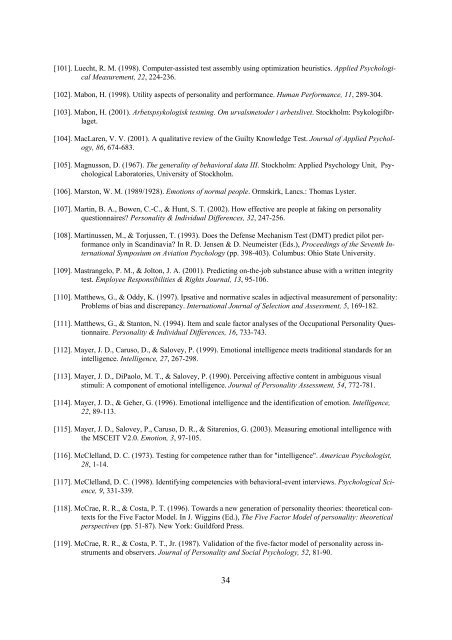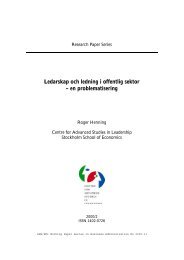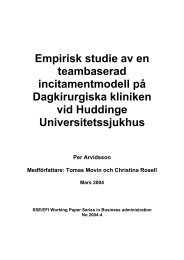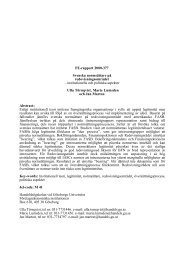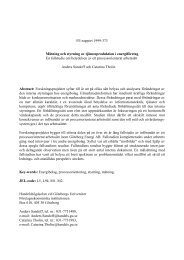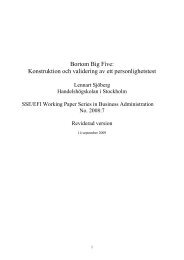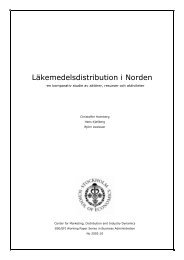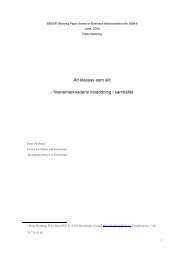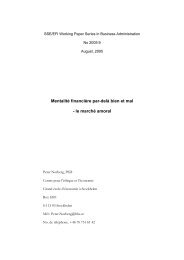personlighetstest i arbetslivet: historik och aktuell forskning
personlighetstest i arbetslivet: historik och aktuell forskning
personlighetstest i arbetslivet: historik och aktuell forskning
You also want an ePaper? Increase the reach of your titles
YUMPU automatically turns print PDFs into web optimized ePapers that Google loves.
[101]. Luecht, R. M. (1998). Computer-assisted test assembly using optimization heuristics. Applied Psychological<br />
Measurement, 22, 224-236.<br />
[102]. Mabon, H. (1998). Utility aspects of personality and performance. Human Performance, 11, 289-304.<br />
[103]. Mabon, H. (2001). Arbetspsykologisk testning. Om urvalsmetoder i <strong>arbetslivet</strong>. Stockholm: Psykologiförlaget.<br />
[104]. MacLaren, V. V. (2001). A qualitative review of the Guilty Knowledge Test. Journal of Applied Psychology,<br />
86, 674-683.<br />
[105]. Magnusson, D. (1967). The generality of behavioral data III. Stockholm: Applied Psychology Unit, Psychological<br />
Laboratories, University of Stockholm.<br />
[106]. Marston, W. M. (1989/1928). Emotions of normal people. Ormskirk, Lancs.: Thomas Lyster.<br />
[107]. Martin, B. A., Bowen, C.-C., & Hunt, S. T. (2002). How effective are people at faking on personality<br />
questionnaires? Personality & Individual Differences, 32, 247-256.<br />
[108]. Martinussen, M., & Torjussen, T. (1993). Does the Defense Mechanism Test (DMT) predict pilot performance<br />
only in Scandinavia? In R. D. Jensen & D. Neumeister (Eds.), Proceedings of the Seventh International<br />
Symposium on Aviation Psychology (pp. 398-403). Columbus: Ohio State University.<br />
[109]. Mastrangelo, P. M., & Jolton, J. A. (2001). Predicting on-the-job substance abuse with a written integrity<br />
test. Employee Responsibilities & Rights Journal, 13, 95-106.<br />
[110]. Matthews, G., & Oddy, K. (1997). Ipsative and normative scales in adjectival measurement of personality:<br />
Problems of bias and discrepancy. International Journal of Selection and Assessment, 5, 169-182.<br />
[111]. Matthews, G., & Stanton, N. (1994). Item and scale factor analyses of the Occupational Personality Questionnaire.<br />
Personality & Individual Differences, 16, 733-743.<br />
[112]. Mayer, J. D., Caruso, D., & Salovey, P. (1999). Emotional intelligence meets traditional standards for an<br />
intelligence. Intelligence, 27, 267-298.<br />
[113]. Mayer, J. D., DiPaolo, M. T., & Salovey, P. (1990). Perceiving affective content in ambiguous visual<br />
stimuli: A component of emotional intelligence. Journal of Personality Assessment, 54, 772-781.<br />
[114]. Mayer, J. D., & Geher, G. (1996). Emotional intelligence and the identification of emotion. Intelligence,<br />
22, 89-113.<br />
[115]. Mayer, J. D., Salovey, P., Caruso, D. R., & Sitarenios, G. (2003). Measuring emotional intelligence with<br />
the MSCEIT V2.0. Emotion, 3, 97-105.<br />
[116]. McClelland, D. C. (1973). Testing for competence rather than for "intelligence". American Psychologist,<br />
28, 1-14.<br />
[117]. McClelland, D. C. (1998). Identifying competencies with behavioral-event interviews. Psychological Science,<br />
9, 331-339.<br />
[118]. McCrae, R. R., & Costa, P. T. (1996). Towards a new generation of personality theories: theoretical contexts<br />
for the Five Factor Model. In J. Wiggins (Ed.), The Five Factor Model of personality: theoretical<br />
perspectives (pp. 51-87). New York: Guildford Press.<br />
[119]. McCrae, R. R., & Costa, P. T., Jr. (1987). Validation of the five-factor model of personality across instruments<br />
and observers. Journal of Personality and Social Psychology, 52, 81-90.<br />
34


